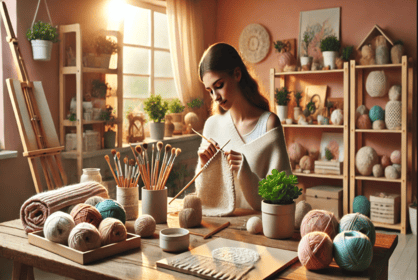Crafting is more than just a creative outlet; it’s a therapeutic activity that can significantly improve mental health. Engaging in hands-on projects like knitting, painting, or DIY crafts provides numerous psychological and emotional benefits, making it a powerful tool for self-care and stress relief. This article explores the positive impacts of crafting on mental well-being and why it’s worth incorporating into your routine.
Reducing Stress and Anxiety
One of the most immediate benefits of crafting is its ability to reduce stress and anxiety. Focusing on a creative task helps divert attention from negative thoughts and daily pressures. The repetitive motions involved in activities like knitting or painting induce a meditative state, calming the mind and reducing feelings of tension.
Crafting also encourages mindfulness, as it requires concentration and staying present in the moment. This state of mindfulness is known to lower cortisol levels, the hormone associated with stress, and promote a sense of relaxation.
Boosting Mood and Combating Depression
Creating something with your hands can provide a deep sense of accomplishment and satisfaction. Completing a project, no matter how small, releases dopamine—a neurotransmitter linked to pleasure and reward. This boost in dopamine can improve mood and help combat symptoms of depression.
Additionally, crafting allows individuals to express emotions through art. For those who find it difficult to articulate their feelings verbally, crafting provides a non-verbal outlet for self-expression, offering relief and clarity.
Enhancing Cognitive Function
Crafting engages multiple areas of the brain, improving cognitive functions such as memory, problem-solving, and spatial awareness. Activities that involve planning, pattern recognition, and fine motor skills, like sewing or assembling models, stimulate mental agility and keep the brain active.
For older adults, crafting can also serve as a preventive measure against cognitive decline. Engaging in creative tasks helps maintain neural connections and can reduce the risk of conditions like dementia.
Fostering Social Connections
Many crafting activities are inherently social. Joining a knitting circle, attending a painting workshop, or participating in online crafting communities provides opportunities to connect with others who share similar interests. These social interactions combat feelings of loneliness and isolation, fostering a sense of belonging and community.
Collaborative crafting projects can also strengthen relationships, whether it’s bonding with family members over a DIY home decor project or creating handmade gifts for friends.
Building Resilience and Self-Esteem
Crafting teaches patience and resilience as it often involves overcoming challenges, such as perfecting a new technique or troubleshooting mistakes. Successfully completing a project builds confidence and self-esteem, as individuals see the tangible results of their effort and creativity.
This sense of achievement reinforces the idea that one can tackle challenges in other areas of life, promoting a growth mindset and a more positive outlook.
Encouraging a Healthy Routine
Incorporating crafting into your daily or weekly routine can provide a sense of structure and purpose. The act of setting aside dedicated time for a creative activity encourages a healthy balance between work, leisure, and self-care.
Crafting can also inspire other positive habits, such as organizing materials, maintaining a tidy workspace, or exploring new skills and hobbies.
Conclusion: Creativity as Self-Care
Crafting is a powerful tool for enhancing mental health, offering a blend of relaxation, self-expression, and cognitive stimulation. Whether you’re painting, knitting, or creating DIY home decor, the act of crafting allows you to connect with your inner self, relieve stress, and foster a sense of accomplishment.
By making time for creative activities, you’re not just making art—you’re nurturing your mental well-being and investing in a healthier, happier you.

